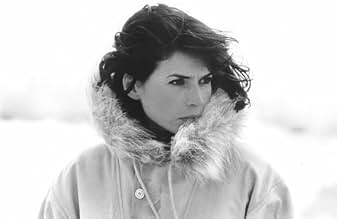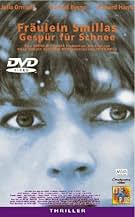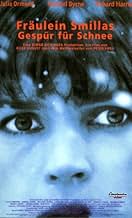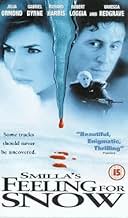Ajouter une intrigue dans votre langueA 6 y.o. Inuit boy runs off a snowy roof in Copenhagen and dies. Smilla, a half Inuit who lives in the building and knows the boy, looks into it. What makes an acrophobic boy run up on the r... Tout lireA 6 y.o. Inuit boy runs off a snowy roof in Copenhagen and dies. Smilla, a half Inuit who lives in the building and knows the boy, looks into it. What makes an acrophobic boy run up on the roof? The clues take her to Greenland.A 6 y.o. Inuit boy runs off a snowy roof in Copenhagen and dies. Smilla, a half Inuit who lives in the building and knows the boy, looks into it. What makes an acrophobic boy run up on the roof? The clues take her to Greenland.
- Réalisation
- Scénario
- Casting principal
- Récompenses
- 1 nomination au total
- Inuit Hunter
- (as Ona Fletcher)
- Pastor
- (as Charles Lewson)
Avis à la une
Nice acting by everyone -- especially Ormond. The film is just so out there, and it wears thin quickly, and goes nowhere slowly. Worth seeing for Ormond's tough girl character though.
The makers succeeded well in capturing the complexity of the book's characters. Julia Ormond does remarkably well as the moody, unpredictable Smilla Jaspersen. So does Gabriel Byrne in the role of the rather secretive Mechanic. The brilliant Richard Harris is in here too, one of the many movies he probably said that it would be his last. The rest of the cast fits in well. Nice to see that they didn't try to get all big names, but rather actors who can fill a role appropriately.
Of course the movie isn't perfect, but in order to give that book full credit, they would have had to make a 4 hour film. Especially the second part, with all the events on the ship and in Greenland, is rather condensed. Those scenes could have used a bit more air to breathe, less pace.
Nevertheless I really like this movie, I have been watching it several times already. And now I think I am going to read the book again... (8/10)
Isaiah and his mother belonged to Denmark's Greenlandic minority, and Smilla herself grew up in Greenland, the daughter of a Danish father and Greenlandic mother. She is in her late thirties, and works as a freelance mathematician and expert on the physics of ice and snow, although she has no formal academic qualifications. She discovers, however, that Isaiah's father was an employee of a Danish mining corporation and that he died in mysterious circumstances during an expedition to Greenland organised by this corporation. She begins to suspect that Isaiah's death was also in some way linked to the company, and learns that they are organising another voyage to Gela Alta, a small island off the coast of Greenland, although she does not know what the object of this voyage is. Nevertheless, she believes that the key to the mystery lies on this remote island and joins the crew of the ship as a stewardess, just ahead of the police who resent her interference in the case and are trying to arrest her.
This was one of those films that I enjoyed more than the original novel. Peter Hoeg's book was itself in some ways reminiscent of a film. The first half, with its urban setting, its tough, gritty investigator and its suggestion of a web of corruption and wrongdoing in high places, reminded me of a Humphrey Bogart style film noir, and the second part, set on the ship as it makes its way through the Arctic ice, of one of those filmed versions of Alistair MacLean thrillers that were so popular in the sixties and seventies. I found, however, that it suffered from an over-complex plot and was too slow moving to work as a thriller. Bille August's version removes some of the complexity of the plot and moves along at a faster pace. The revelation about exactly what lies below the ice comes earlier in the film than it does in the book- possibly August realized that the book's ending, more science fiction than science fact, was one of its weak points, and wanted to get this detail out of the way to allow the closing scenes of the film to concentrate more on the battle between Smilla and the villains. The film keeps, however, the book's atmospheric sense of place- there were some wonderful shots of Copenhagen in winter and of the Arctic ice.
Julia Ormond seemed to be the cinema's Big New Thing of the mid-nineties. Her role in 'Smilla's Sense of Snow' followed starring roles in three big Hollywood films, 'Legends of the Fall', 'First Knight' and 'Sabrina'. Since then she seems to have disappeared from the radar altogether and I have often wondered what has happened to her.. Her performance in 'Smilla', however, is a good one and she makes an appealing heroine. Rather more appealing, in fact, than Hoeg's original character, who combines a strong sense of justice with a gift for rudeness and sarcasm. Of the other actors, the best was Richard Harris as the chief villain, although he was probably considerably older than the character envisaged by Hoeg.
Although it is very different in its visual style, this atmospheric thriller is perhaps the nearest that the modern cinema comes to old-fashioned film noir. Despite its weaknesses it remained watchable throughout. It confirmed my view (based on 'Pelle the Conqueror' and 'The House of the Spirits') that Bille August is a highly talented director. 7/10
Le saviez-vous
- AnecdotesDuring filming on location in Greenland Richard Harris got into the freezing water of the Arctic for a scene where he has to try and climb out of the water onto an ice floe. Afterwards he said it was madness that he had agreed to do it.
- GaffesWhen Smilla's father shows her the X-rays of the worms in the heart, he points out what remains of the liver and lower esophagus, then says "This is the heart, what's left of it". He's actually pointing to an upside-down X-ray of the upper abdomen. The "heart" is actually bowel gas in the intestine.
- Citations
Smilla: The number system is like human life. First you have the natural numbers. The ones that are whole and positive. Like the numbers of a small child. But human consciousness expands. The child discovers longing. Do you know the mathematical expression for longing? The negative numbers. The formalization of the feeling that you're missing something.
- Bandes originalesQuis est homo
from "Stabat Mater"
Written by Giovanni Battista Pergolesi
Performed by Kammerorchester 'Carl Philipp Emanuel Bach'
Conducted by Hartmut Haenchen
Meilleurs choix
- How long is Smilla's Sense of Snow?Alimenté par Alexa
Détails
- Date de sortie
- Pays d’origine
- Langues
- Aussi connu sous le nom de
- Smilla et l'amour de la neige
- Lieux de tournage
- Sociétés de production
- Voir plus de crédits d'entreprise sur IMDbPro
Box-office
- Budget
- 35 000 000 $US (estimé)
- Montant brut aux États-Unis et au Canada
- 2 372 903 $US
- Week-end de sortie aux États-Unis et au Canada
- 107 108 $US
- 2 mars 1997
- Montant brut mondial
- 2 372 903 $US
- Durée2 heures 1 minute
- Couleur
- Mixage
- Rapport de forme
- 2.35 : 1
Contribuer à cette page

































